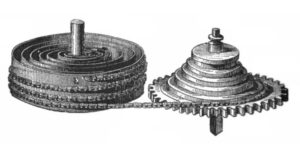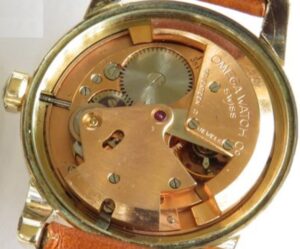A mechanical watch is a complicated piece of machinery, with dozens of tiny parts working in perfect harmony. At the centre of it all is the mainspring barrel, the crucial component responsible for powering the entire movement. Understanding how the mainspring barrel works, along with its various types and historical developments, helps us appreciate the intricate craftsmanship of these timepieces.
What is the mainspring barrel?
The mainspring is the driving force of a mechanical watch, and the mainspring barrel is the small cylindrical container that houses it. Often, this barrel has a geared rim, allowing it to engage with the rest of the watch’s movement. Inside the barrel, the mainspring coils around a central axle known as the arbor. One end of the mainspring is fixed to the arbor, while the other end is secured to the inner wall of the barrel. When the mainspring unwinds it provides the power that drives the watch. The balance wheel, combined with the hairspring, is the critical timekeeping component of the movement. However, without the power from the mainspring the watch will simply fail to tick.

When the watch is wound, either by hand or automatically, the mainspring tightens around the arbor, storing energy. As it gradually unwinds, it releases this stored energy, driving the gear train and regulating the movement of the hands. The escapement, ensures accurate timekeeping, by controlling the release of power from the mainspring (The mainspring at Hodinkee).
The design of the mainspring barrel has evolved over the centuries, leading to various mechanisms that improve efficiency, accuracy, and durability.
Simple mainspring barrel
The simplest type of mainspring barrel directly transmits power to the watch’s gear train. In this setup:
- The mainspring is attached at one end to the arbor and the other end to the barrel wall.
- Turning the barrel, which tightens the mainspring around the arbor, winds the watch.
- As the mainspring unwinds, it rotates the barrel in the opposite direction, transferring energy to the gear train.
This basic design is very simple. However, it has a few drawbacks. One major issue is isochronism, where the watch runs at different speeds depending on how much power remains in the mainspring. A fully wound mainspring exerts more force, causing the watch to run faster. In contrast, a near-empty mainspring provides weaker power, slowing the movement.

Another issue is the lack of maintaining power. When the watch is being wound, no power is transferred to the gear train, causing the watch to momentarily stop. Additionally, early steel mainsprings were prone to breaking. If a mainspring snapped, the sudden release of energy could severely damage the delicate gears and jewels inside the movement. Simple mainspring barrels were phased out by the early 19th century because of these limitations.
The fusee: an early solution to isochronism
To address the isochronism problem, early watchmakers developed the fusee mechanism. This clever system used a conical gear, the fusee, to regulate power delivery.
In a fusee system:
- A small chain (similar to a miniature bicycle chain) connects the mainspring barrel to the fusee.
- The chain wraps around the fusee, starting from the wide base and moving toward the narrow top, this winds the watch.
- As the mainspring unwinds, the chain shifts back onto the barrel, adjusting the leverage applied to the fusee.

By altering the force distribution as the mainspring unwinds, the fusee ensured that the power delivered to the gear train remained constant. This system greatly improved accuracy and featured widely in high-end pocket watches until the mid-19th century (What is a “Fusee” pocket watch? at the Watch Museum).
Going barrel: a more reliable alternative
The going barrel became the dominant design in the 19th and 20th centuries. It improved on the simple mainspring barrel by introducing a ratcheted winding gear attached to the arbor. This is how it works:
- Turning the arbor winds the mainspring, instead of the barrel.
- The outer rim of the barrel is geared, directly engaging with the watch’s gear train.
- The barrel continues to deliver power while being wound. This maintains power, keeping the watch running smoothly.
Going barrels became the standard for both pocket and wristwatches, offering better reliability and efficiency compared to earlier designs.
The safety pinion: protecting against mainspring breakage
As mainspring barrels evolved, watchmakers introduced the safety pinion to prevent damage from broken mainsprings. In a reversing pinion system:
- The centre wheel pinion (which receives power from the barrel) is threaded onto the arbor with a reverse screw thread.
- Under normal operation, the power from the mainspring keeps the pinion securely fastened.
- If the mainspring breaks, the sudden reversal of force causes the pinion to unscrew rather than transmit the shock to the gear train.

This simple yet effective mechanism saved countless watches from catastrophic damage and became a hallmark of quality watchmaking.
Safety barrel and motor barrel: enhanced protection
As watchmakers refined their designs, they introduced safety barrels and motor barrels, both aimed at limiting the damaging effects of mainspring failure.
Safety barrel
The safety barrel connected the arbor and barrel through a square hole-and-shoulder mechanism. If the mainspring broke, the arbor absorbed the force rather than the delicate gears, reducing the risk of damage.
Motor barrel
A motor barrel reversed the traditional power transmission method:
- The turning barrel winds the mainspring.
- The arbor, rather than the barrel, transmitted power to the gear train.
This design meant that, in the event of a mainspring breakage, excess force was directed to the winding mechanism instead of the delicate internal components. Many high-end watches feature motor barrels for added durability and efficiency.
Jewelled motor barrel
Some of the finest watches took the motor barrel concept further by jewelling the barrel arbor. Adding synthetic rubies or sapphires which reduced friction, enhancing efficiency and extending the lifespan of the movement. The practical benefits may have been small. However, jewelled motor barrels became a hallmarks of luxury timepieces.
Automatic winding: the next revolution
British watchmaker, John Harwood, invented the first practical self-winding (automatic) movement in 1923. His design used a pivoted oscillating weight that moved back and forth with the wearer’s wrist motion, winding the mainspring. Although Harwood’s design was revolutionary and led to patents and commercial production, financial difficulties and the Great Depression hindered its success. However, by the mid-20th century, self-winding watches revolutionised the industry. Automatic winding mechanisms use a rotor, a weighted component that swings with wrist movement.
- The rotor engages a winding mechanism, applying force to the mainspring.
- A clutch system prevents over-winding by allowing controlled slippage once the mainspring reaches full tension.
This innovation meant wearers no longer needed to wind their watches manually, making mechanical timepieces even more convenient and reliable.
Conclusion
The evolution of the mainspring barrel showcases the ingenuity of watchmakers over the centuries. From simple barrels to sophisticated motor barrels and automatic winding systems, each innovation has improved timekeeping accuracy, reliability, and efficiency. Whether you’re a collector or simply appreciate fine craftsmanship, understanding the mainspring barrel reveals the fascinating complexity hidden inside every mechanical watch.
Related content
Mainspring at Wikipedia.

Leave a Reply